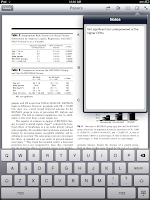Today we had a patient with rhabdomyolysis. The UpToDate card, Clinical features and prevention of heme pigment-induced acute tubular necrosis, has this to say about bicarbonate and mannitol:

In a large series of 382 patients with serum CK concentration >5000 U/L, 154 (40 percent) were treated with bicarbonate and mannitol [33]. There was no statistically significant difference in the incidence of renal failure (creatinine >2.0 mg/dL [177 micromol/L]; 22 versus 18 percent), dialysis (7 versus 6 percent), or death (15 versus 18 percent) in patients who were or were not treated with bicarbonate and mannitol. However, there was a trend toward improved outcomes in patients with extremely high CK levels (>30,000 U/L) treated with bicarbonate and mannitol.Reference 33 is the primary reference for one of my first blog posts. We started talking about this study on rounds, but the crap machines in the ICU didn't have Flash or PDF support. I ended up downloading the PDF on my iPhone and four of us passed it around to look at some of the figures. The iPad doesn't have flash but it does a beautiful job rendering PDFs. I have the article in Papers which does an awesome job at holding and organizing my entire medical library.
Basic review of Papers
 Papers is iTunes for scientific Papers. It is the modern equivalent to the file cabinet you always wanted for all the important scientific articles that fall into your grubby little hands. My computer is littered with literally hundreds of scientific articles. What you want to do is throw them all into Papers.
Papers is iTunes for scientific Papers. It is the modern equivalent to the file cabinet you always wanted for all the important scientific articles that fall into your grubby little hands. My computer is littered with literally hundreds of scientific articles. What you want to do is throw them all into Papers.To understand the power of Papers, let's look at the workflow for getting a PDF into Papers and onto the iPad. After downloading reference 33, drag it into Papers. It initially looks like this:
Then you click on Match and quickly find the article's reference in PubMed or Google Scholar or another database. To do this I copied the author's name and entered the year of publication.
After you double click the correct reference all of the meta-data quickly populates the appropriate fields so the you have all the data you need.
Papers even renames the original file, so your reference article folder is organized with logically named files.
To sync your library between your Mac and iPad, just run Papers on both devices simultaneously and it will synchronize your entire Library or specified subset (actually, it is limited to 1,000 articles). Syncing occurs over wifi.
On the iPad, when you launch Papers, you are in the Library.
Search on bicarbonate and you find a couple of articles on the use of bicarbonate to prevent contrast nephropathy, one on its use to treat severe metabolic acidosis, and one on its use to prevent the renal complications rhabdomyolysis...bingo!

Once you have the article you can read it in landscape with some of the meta data revealed or portrait for a more paper-like experience
Papers also works on the iPhone but after using it I thought it was a bit of a gimmick, I didn't really want my PDF library on a 3.5 inch screen. The iPad makes a perfect partner for the desktop app. I'm very excited about this.
Papers for MacOS is $42.00, the iPhone/iPad application is $14.99.










